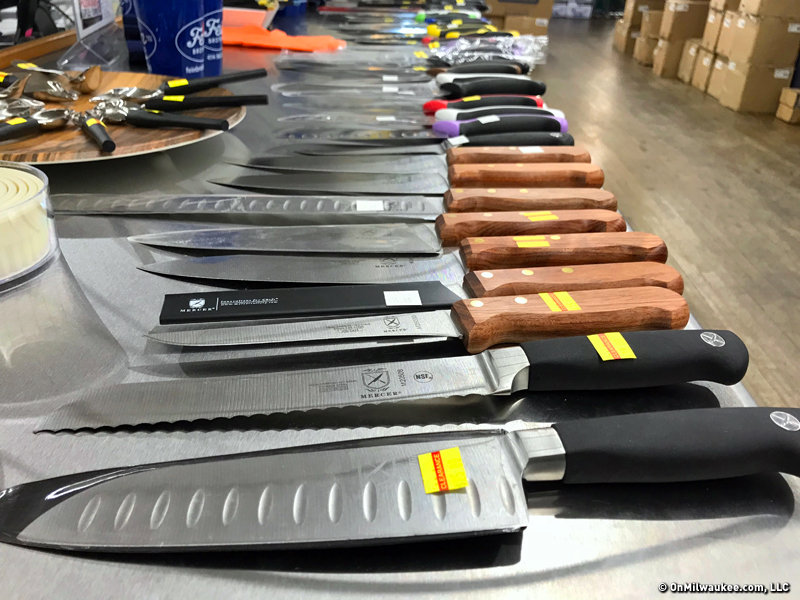The spice rack. We all have one. Or in my case, what once was a spice cupboard replete with decade-old powders and amalgamated configurations of salt, bleached, then colored, then packaged and labeled as "fish seasoning" or "steak seasoning."
I've since purged most of these inherited dust vials, and today you will find nutmeg, sweet curry powder, cinnamon, saffron, lavender, Korean chili threads or Madagascar vanilla beans. More importantly, what you won't find is dried herbs, onion powder or garlic salt.
Why?
On a rainy Wednesday afternoon at the Frontier Airlines Center, I strolled through the annual Wisconsin Restaurant Expo in search of new and exciting products with which to enhance my menus and inspire my epicurean appetite.
As I surveyed a line-up of dried herbs and powdered "this and that," I asked the grandfatherly gentleman at the booth, "Are these all natural?" He responded proudly. "Yes, our spices are all natural." I then asked, "Are they irradiated?"
A big smile appeared on his face. I was talking his language now. As if to ease my worries about pathogen-infected seasonings, he stuck out his chin and delightfully proclaimed his line of herbs and spices to be, indeed, irradiated. I said thank you and moved on.
So, what's irradiation? Sounds like radiation, right? That's because it is. It's a process that is widely used to kill microorganisms in dried herbs and spices. Seems like a good idea doesn't it? "I don't want to get sick from my dried, crunchy, flavorless, swampy-green parsley, do I?" Of course you don't.
But aside from having little culinary value, garlic salt, onion powder and dried basil may not be particularly good for you either.
"But chef," you ask, "isn't there a thrilling nouvelle cuisine afoot called molecular gastronomy that is predicated on pulverizing commonplace ingredients and repurposing classic flavor combinations by dispelling their compositions at the molecular level?" Yes. While my personal culinary style may be a tad more wholesome, I respect the invention and innovation of this movement despite its price tag.
This, however, is not what I'm talking about. Certainly, you can find all sorts of intriguing re-constitutions on a plate such as sea salt foam or shitake mushroom powder. But, in virtually all instances, these inventions are realized in the restaurant kitchens themselves and are arrived at organically. It's sort of like the difference between someone being paid to create a large painted mural on the interstate overpass and someone just vandalizing it without sanction.
The reasoning behind irradiation is valid. The goal is plain. But, as with so many of the unpleasant truths we continue to learn about where our food comes from, irradiation is a tricky bird with all sorts of unknowable risks and a nuanced process that I hope will have you opting for fresh parsley, garlic cloves and those big white things that make you teary when you slice into them.
I could write an entire article about the flavor benefits of fresh ingredients versus dried. But, we'll just say, coming from a chef, that's self-evident. Instead, I'd like to pull back the curtain on this curious practice and the FDA-approved steps for making it "safe."
The intention of my culinary scribblings is partly to be entertaining, so I'm not about to put you to sleep by detailing the scientific "ins and outs" of irradiation. I will, however, touch on the main aspects of the process.
But first, let's understand that the expressed goal of this system is to eliminate potentially harmful pathogens from food to make it suitable for consumption. If there is a technology that can prevent us from contracting E.coli and salmonella from foods, we should probably want to support that (nevermind the question of how it got there to begin with).
Most simply put, food is sent on a conveyor through a concrete fortress (like the illustration above) and exposed to controlled amounts of ionizing radiation by way of a gun similar to a television tube.
From the UW-Madison website on food irradiation:
"When microbes present in the food are irradiated, the energy from the radiation breaks the bonds in the DNA molecules, causing defects in the genetic instructions. Unless this damage can be repaired, the organism will die or will be unable to reproduce."
This means that your dried herbs and spices are full of dead bugs. OK, maybe I'm exaggerating just a bit for effect but ... maybe not. The FDA has approved irradiation of meat and poultry and allows its use for a variety of other foods including fresh fruits, vegetables and spices. Realize though, this is less to protect you and more to protect the food. It enables food to be grown, harvested and subsequently stored for much longer periods of time and with a decreased risk of spoilage.
Whole Foods Market asserts that "Not all food authorities support irradiation and even the strongest proponents acknowledge that irradiation is no match for bad sanitation and substandard practices. Irradiation can only help control the contamination once it occurs; it cannot prevent it."
Essentially, irradiation is a cop out. Its anticipated use can discourage strict adherence to good sanitary practices. Bill Freese, a science policy analyst with the Center for Food Safety in Washington calls it a "pseudo fix."
"It's a way to try to come in and clean up problems that are created in the middle of the food production chain," says Freese. "I think it's clearly a disincentive to clean up the problems at the source."
While processors of irradiated food are subject to all existing regulations, there is no mandated regulatory oversight. In other words, they are not subject to regular plant inspections. This, in effect, necessitates the use of irradiation. You know that old saying about how you'd never eat a hot dog if you saw how it was made? Well, that may be true for your dried oregano as well.
Irradiation of fruits and vegetables and meat and poultry is not widely practiced yet. However, almost all wholesale dried herbs and spices are irradiated. Furthermore, the European Union has regulated that only dried herbs and spices may be subject to this process. That said, Europa, the European commission for food and feed safety, follows a far stricter code of food-flow from the source. Irradiation is used as a final "only-in-some-cases" measure.
There are many wonderful ethnic cuisines that are rooted in the use of dried spices. In Mexican or Indian cuisine, for example, where the path to deep rich flavors starts with what we know as "low and slow" cooking methods, these bright, wholesome spices only approach their brilliant apex through proper use and long, careful cooking.
For these wonderful dishes, dare you attempt them, there are un-irradiated spices available at places like Whole Foods Market, Trader Joe's or just your neighborhood spice shop.
If you're waiting for me to tell you that irradiation has been linked to diseases, birth defects or other maladies, I can't say that. But that's sort of the point – it's unknowable. Irradiation is another form of preventative maintenance born out of our industrial food production system.
The lack of long-term studies should be further reason for us to cease irradiating foods in order to attain more information about its life-long affects.
When the FDA says that this practice "does not change the nutritional value of foods and they don't become dangerous as a result of irradiation," what they're really saying is that no one else can prove otherwise. In essence, the lack of data is the very vehicle for its proliferation.
Now, I'm well aware of how exhausting it can be to keep up with all the latest atrocities of our food factories. There's always something to be appalled by. Maintaining a purely organic, natural and unfettered diet of as-nature-intended foods is virtually impossible in a world were organic food is not the standard but a commodity.
But, if the thought of the food you consume being exposed to gamma rays isn't enough of a cause for concern and your mind is adequately put at ease by the FDA's ardent claim that irradiation is "perfectly safe," I would only ask you this: why purchase anything that is dried or powdered when the fresh version of it is three aisles over?
Justin has been featured in such notable publications as Food Service Director, Today's Dietician and the ACF's National Culinary Review. Most recently, Justin was the executive chef at Milwaukee's renowned art deco hotel, Hotel Metro. Today, Justin enjoys writing and demonstrating at community events and festivals, also making regular appearances on WISN 12's Saturday morning news. Justin plans to return to restaurants some day but is not sure when or where. In the meantime, he enjoys spending time with his wife and three boys.







